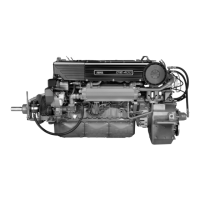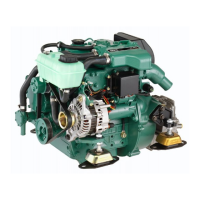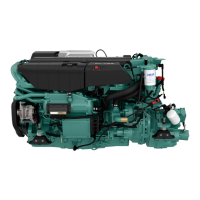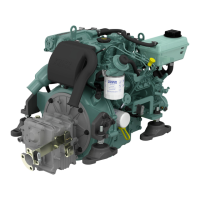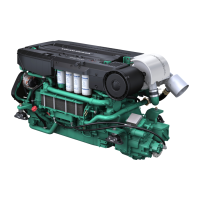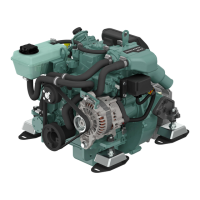Do you have a question about the Volvo Penta D12-615 and is the answer not in the manual?
Guidelines for safe operation of the boat and engine.
Precautions and procedures for safe maintenance and repair.
Requirements for certified engines and warranty details.
Detailed technical specifications and components of the engine.
Location and importance of engine and transmission identification plates.
Description of gauges, ignition keys, and start/stop panel.
Warning lamps and their meanings during engine operation.
Adjusting the friction brake for lever movement stiffness.
Operation and disengaging the shift function for electronic single lever controls.
Operation and friction brake adjustment for mechanical two lever controls.
Pre-start checks including fuel, sea cocks, and initial starting procedures.
Step-by-step procedure for starting the engine.
Procedure for starting the engine and initial warm-up.
Interpreting gauge readings and understanding alarm indicators during operation.
Optimizing cruising speed and synchronizing twin engines.
Changing control panels and positions during operation.
Engaging and disengaging low speed and trolling functions.
Operation of flushing and bilge pump systems.
Normal stop, emergency stop, and post-shutdown checks.
Preparing the engine for cold weather or extended storage.
Procedure for jump-starting the engine using auxiliary batteries.
Manual shifting of the reverse gear in emergency situations.
Identifying, diagnosing, and reading engine fault codes.
Procedures for clearing fault codes from the system.
Overview of scheduled maintenance tasks and intervals.
General inspection and maintenance for the engine.
Oil change intervals, grade, viscosity, and filter replacement.
Coolant mixture, level checks, filling, and draining procedures.
Draining, anode checks, impeller, and filter maintenance.
Fuel system venting, filter changes, and inspection.
Maintenance of main switches, connections, batteries, and charging.
Checking oil level, cleaning strainers, and changing filters for reverse gears.
Guidelines for safe operation of the boat and engine.
Precautions and procedures for safe maintenance and repair.
Requirements for certified engines and warranty details.
Detailed technical specifications and components of the engine.
Location and importance of engine and transmission identification plates.
Description of gauges, ignition keys, and start/stop panel.
Warning lamps and their meanings during engine operation.
Adjusting the friction brake for lever movement stiffness.
Operation and disengaging the shift function for electronic single lever controls.
Operation and friction brake adjustment for mechanical two lever controls.
Pre-start checks including fuel, sea cocks, and initial starting procedures.
Step-by-step procedure for starting the engine.
Procedure for starting the engine and initial warm-up.
Interpreting gauge readings and understanding alarm indicators during operation.
Optimizing cruising speed and synchronizing twin engines.
Changing control panels and positions during operation.
Engaging and disengaging low speed and trolling functions.
Operation of flushing and bilge pump systems.
Normal stop, emergency stop, and post-shutdown checks.
Preparing the engine for cold weather or extended storage.
Procedure for jump-starting the engine using auxiliary batteries.
Manual shifting of the reverse gear in emergency situations.
Identifying, diagnosing, and reading engine fault codes.
Procedures for clearing fault codes from the system.
Overview of scheduled maintenance tasks and intervals.
General inspection and maintenance for the engine.
Oil change intervals, grade, viscosity, and filter replacement.
Coolant mixture, level checks, filling, and draining procedures.
Draining, anode checks, impeller, and filter maintenance.
Fuel system venting, filter changes, and inspection.
Maintenance of main switches, connections, batteries, and charging.
Checking oil level, cleaning strainers, and changing filters for reverse gears.
| Engine Model | D12-615 |
|---|---|
| Power Output | 615 hp |
| Number of Cylinders | 6 |
| Fuel System | Common rail |
| Engine Type | Diesel |
| Displacement | 12.1 liters |
| Bore | 131 mm |
| Stroke | 150 mm |
| Cooling System | Freshwater |
| Aspiration | Turbocharged |
| Emission Standards | IMO Tier II |
